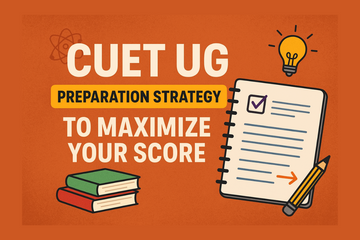The Common University Entrance Test - Undergraduate (CUET-UG) is today one of the most important gateways for students aiming to join central, state, and many private universities in India. To do well, it’s not enough just to “study hard” – you need a smart, organized strategy, consistent practice, and good resources.
In this blog, I will share a full-fledged preparation roadmap (from start to exam day) and also highlight how GK Publications resources, especially their CUET series, can be integrated into your plan to maximize your score.
Understanding the Exam: Pattern, Syllabus & Weightage
Before diving into studying, you must know exactly what you are preparing for. Here’s the CUET UG structure:
- The exam is MCQ-based.
- It has three main sections:
1. Language Tests (Section IA / IB)
2. Domain-specific Subject Tests (your subject(s) of choice)
3. General Test (Quantitative Ability, Logical & Analytical Reasoning, General Knowledge & Current Affairs) - For each correct answer, you typically get +5 marks, and wrong answers lead to a penalty (negative marking) of −1 mark.
- You need to choose your domain subjects wisely (usually aligned with what you studied in Class 11/12) so that you can manage depth and speed.
Because the syllabus overlaps a lot with your school curriculum (especially NCERT in many cases), the advantage goes to those who combine board exam preparation with CUET preparation.
Also note: in 2025, there's a specific update — Accountancy’s exam pattern has been revised, giving students a choice between Unit V and a newly introduced optional unit. So always keep track of NTA’s updates.
Where to Begin & How to Progress?
Here is a stepwise, phased strategy that you can adapt depending on how much time you have (3 months, 6 months, 12 months).
Phase 0: Diagnostic & Planning (First 1–2 weeks)
- Take a diagnostic test (either past CUET papers or a full mock test of all sections) to see your strengths and weaknesses.
- Map the syllabus: List all topics in each section. Identify which topics are “must-score / high frequency” vs “low yield / optional.”
- Set realistic goals and a weekly schedule: Decide how many hours per day you can devote, and allocate blocks to each section (Language, Domain, General Test).
- Gather your resources: Collect your textbooks (NCERT / school), reference books, practice books, and mock test series.
Phase 1: Concept Building & Foundation (Months 1–3)
- Language Section: Work on grammar, vocabulary, and reading comprehension. Read editorials, newspapers, and practice MCQs.
- Domain Subjects: For each subject, go through the theory thoroughly (from NCERT and reference texts). Make short notes, mind maps, and formula sheets.
- General Test: Start with Quantitative Ability and Logical Reasoning basics; for GK/Current Affairs, maintain a habit of daily reading and short quizzes.
In this phase, aim for clarity first, rather than speed. Understand why a solution works, note down shortcuts, and revise regularly.
Phase 2: Practice & Drill (Months 4–6 or up to exam)
- Increase the number of topic-wise and full-length mocks. Time yourself strictly.
- Analyze each mock: check which questions you got wrong (and why), note down weaknesses, and rework those topics.
- Do mixed sectional tests (for example, a mix of Domain + General Test) to simulate real exam conditions.
- Revise your notes and formula sheets frequently.
As the exam nears, shift toward more revision, mocks, and time management practice.
Phase 3: Final Revision & Exam Readiness (Last 2–4 weeks)
- Focus on revision and speed. Use concise notes, flashcards, and formula sheets.
- Take full-length mocks under exam timing.
- Simulate the exam environment (no distractions, same timings).
- Work on exam-day strategy: which sections to attempt first, how much time to allot per question, when to skip, and return.
- Stay calm, healthy, and focused: sleep, good food, and short breaks.
Section-Wise Tips & Best Practices
1. Language Tests (English / Other Languages)
- Focus heavily on reading — editorials, opinion pieces, articles in good newspapers/magazines.
- Build vocabulary using word lists, root words, and flashcards.
- Practice grammar rules and MCQs (error spotting, fill in the blanks, sentence correction).
- Take passage-based reading exercises to build speed.
2. Domain-Specific Subject(s)
- Start from fundamentals (NCERT or your school syllabus).
- Use reference books and guides to deepen understanding.
- Solve previous years’ CUET papers or sample papers in your domain to understand the pattern and difficulty.
- Use GK Publications’ subject-specific practice books (see below) to drill into exam-style questions.
3. General Test (Quantitative + Reasoning + GK / Current Affairs)
- Quantitative Ability: practice arithmetic, algebra, geometry, number system, data interpretation, ratios, percentages, etc. Use shortcut techniques/faster methods.
- Logical & Analytical Reasoning: practice puzzles, seating arrangement, syllogism, logical connectives, statements & arguments, series, coding-decoding.
- GK / Current Affairs: daily reading of newspapers (editorials, national/international news), monthly current affairs compilations, one-liners, awards, appointments, science and tech updates.
Time management is especially critical here, since the General Test can be tricky with a mix of topics.
How Can We Help You?
GK Publications has a dedicated collection of CUET (UG) books developed in collaboration with Career Launcher. Our offerings include:
· CUET (UG) 2025: English, Reasoning & Quant - 30 Practice Paper Tests: It provides 30 practice paper tests, divided equally across English, Reasoning, and Quantitative Aptitude. This book is ideal for students who want a blend of practice and conceptual understanding to enhance their exam preparation.
· NTA CUET (UG) 2025: Economics - 1000 Practice Questions: For students who have Economics as their subject in CUET UG, this book is a must-have. It comes with 1000 chapter-wise practice questions. In addition, it includes 5 actual solved CUET papers (2022–2024).
· NTA CUET (UG) 2025: Computer Science - 10 Practice Sets: Computer Science aspirants preparing for CUET UG can rely on this book for complete practice. It includes 10 practice sets—with 5 mock tests for practice and 5 solved papers for reference.
· NTA CUET-UG 2025: Humanities - 47 Previous Year Solved Papers: Humanities students appearing for CUET UG have a wide range of subjects to prepare for. This book provides 47 previous year solved papers covering Geography, History, Political Science, Psychology, and Sociology. It helps students understand exam patterns, question types, and marking schemes in detail.
· NTA CUET-UG 2025: Commerce - 53 Previous Years Solved Papers: Commerce students preparing for CUET UG 2025 will find this book extremely useful. It offers 53 previous years’ solved papers, covering Accountancy, Business Studies, and Economics.
· CUET 2025: 60 Days Prep Strategy: For students who are short on time and want a structured 60-day plan to prepare for CUET, this book is a game-changer. It provides a strategic daily plan, covering all key sections of the exam—Quantitative Aptitude, English, Reasoning, and General Knowledge. Additionally, it includes 2 free online mock tests to give students a real exam-like experience.
· GKP also provides free resources, sample PDFs, and updates via their blog.
One great thing about GKP’s CUET series is that the content is aligned with the latest CUET pattern (they frequently update editions), and they incorporate actual solved papers to maintain relevance.
Use GKP as a backbone, but complement it with NCERT, reference texts, and other good practice material.
Common Pitfalls & How to Avoid Them?
- Neglecting revision — Many students learn new topics but forget to review regularly. Use spaced repetition.
- Skipping error analysis — After every mock, analyze mistakes deeply. Don’t just mark them wrong — understand why.
- Doing random tests without structure — Instead, progress from topic-wise → sectional → full-length in a staged manner.
- Overemphasis on one section — Don’t let one subject dominate all your time; maintain balance.
- Ignoring newer exam updates — Stay alert to NTA or CUET format changes (e.g., Accountancy changes in 2025).
- Stress & burnout — Include breaks, sleep, and fun to maintain mental health.
Final Thoughts: Mindset & Execution
- Consistency beats intensity: It’s better to study 2 hours daily for 6 months than 10 hours just 2 months before.
- Quality matters more than quantity: Focused study, solved problems, and full mocks are more useful than passive reading.
- Adapt and iterate: If a strategy isn’t working, be flexible to change it.
- Confidence & calmness: On exam day, don’t let panic take over. Stick to your plan and manage time smartly.








9a9vl4
u9ffmh